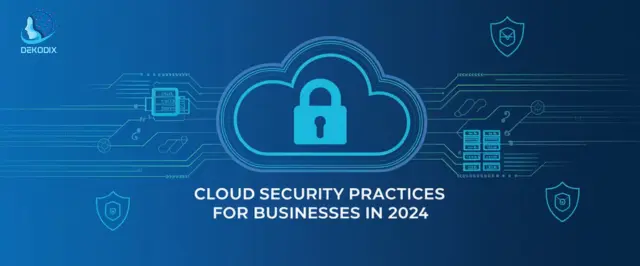Cloud Security Best Practices for Businesses:
Fortifying Your Digital Landscape!
Introduction
As the digital world undergoes rapid transformation, organizations notice its advantages, such as scalability, flexibility, and cost reduction. As more and more businesses move their operations online, storage cloud security is becoming an increasingly pressing issue. Protecting sensitive data stored in the cloud is critical, especially now that cyberattacks are becoming increasingly dangerous. A successful cloud security strategy facilitates business operations and customer trust. This article will discuss proven approaches to cloud security, potential issues businesses face, and how Dekodix can help.
Demystifying Cloud Security
What is Cloud Security?
Information systems, applications, and data stored in the cloud are part of “cloud security,” which includes rules, technologies, and procedures designed to ensure their security. Unlike traditional security measures focusing primarily on physical protection, such as firewalls and network locks, cloud security protects digital assets from changing environments. It also covers broader issues related to shared environments and multi-tenant infrastructure.
The Shared Responsibility Model
The concept of shared responsibility for cloud security is critical. The security of data and applications stored in the cloud is a shared responsibility between the enterprise and the cloud service provider (CSP).
- Cloud computing: Service providers are responsible for the security of the underlying networks, data centers, and physical servers that make up the cloud.
- Companies: In a cloud environment, enterprises must protect their data, applications, and configurations.
Enterprises must understand their responsibilities regarding cloud assets to protect them adequately.
Data Protection and Cybersecurity in the Cloud
At its core, cloud security is about keeping your data safe. Businesses must implement strong security measures to protect sensitive information and comply with industry laws. Adopting a proactive strategy to secure the cloud is critical to protecting digital assets from increasingly sophisticated cyber threats.
Best Practices for Cloud Security
Identity and Access Management (IAM)
Multi-Factor Authentication (MFA)
One of the best options to improve cloud security is multi-factor authentication (MFA). To make it harder for unauthorized people to access user accounts, multi-factor authentication (MFA) requires users to pass two or more verification steps. Instead of passively allowing anyone to make unauthorized login attempts, companies can reduce access risks by requiring employees to provide passwords and items, such as smartphones or security tokens.
Role-Based Access Control (RBAC)
Role-based access control (RBAC) is an essential IAM technology. Using RBAC, organizations can better assign user permissions based on their roles, reducing data leaks and security breaches and creating a more secure environment. Users can only access the resources they need to do their jobs.
Encryption and Data Protection
Encrypting Data at Rest and in Transit
Businesses must ensure the security of sensitive data during storage and transmission, so data encryption is an integral part of enterprise cloud security. Because encryption programs convert information into an unreadable format without providing access keys, hackers will find gaining access to critical assets more challenging.
Key Management Policies
Protecting data requires strict implementation of critical management practices. To provide the highest level of security, businesses must take steps to generate, store, and rotate encryption keys. Although encryption is very efficient, good key management can reduce the likelihood of unauthorized access to sensitive information.
Regular Security Audits and Compliance
Vulnerability Assessments and Penetration Testing
You need to conduct regular security audits to detect security flaws in your cloud setup. Companies should conduct vulnerability and penetration testing to assess their security procedures and identify any vulnerabilities that hackers could exploit. By conducting audits regularly, companies can stay ahead of emerging dangers and ensure that their current security measures are sufficient.
Compliance with Industry Regulations
Companies in regulated industries must ensure compliance with industry regulations, such as HIPAA and the General Data Protection Regulation (GDPR), to protect sensitive information and avoid costly fines. Maintaining compliance through regular audits demonstrates diligence to stakeholders.
Monitoring and Threat Detection
Automated Monitoring Tools
Security teams can use automated monitoring systems to monitor suspicious behavior in real time and prevent threats before they can cause damage. With the continuous monitoring that cloud environments provide, businesses can stay informed about the latest cyberattacks and intrusion attempts.
Intrusion Detection and Prevention Systems (IDPS)
By monitoring network traffic for signs of unusual activity and automatically identifying threats that require measures to prevent attacks, intrusion detection systems (IDPS) can strengthen cloud security, giving users more defenses against any danger.
Data Backup and Disaster Recovery Planning
Developing a Disaster Recovery Plan
Maintaining business continuity in unforeseen situations requires an efficient disaster recovery strategy. Businesses must have comprehensive strategies to recover data and continue operations during cybersecurity breaches, natural disasters, or hardware failures. Plans should include the processes to follow, the people involved, and the resources needed for recovery.
Multi-Region Backups
Businesses looking to protect against data loss should maintain backups in many cloud locations to increase resiliency and reduce recovery times. Backups in multiple regions improve resiliency and minimize recovery downtime.
The Role of Dekodix in Strengthening Cloud Security
Dekodix understands its customers’ needs. Cloud security can be difficult to understand, so our entire suite of services is designed to enhance cloud security while ensuring your data is protected and private.
Cloud Security Consultation
Our cloud security experts provide professional consulting services to review your current infrastructure and identify weaknesses. We work directly with organizations to design security policies based on their needs and risk profiles.
Identity and Access Management (IAM) Solutions
At IAM Solutions, we implement IAM solutions such as MFA and RBAC to ensure that only authorized users can access cloud services. We continuously manage access restrictions, reducing security risks while preventing sensitive data from being disclosed to unauthorized parties.
Encryption Implementation and Key Management
Dekodix provides key management and encryption compliance solutions to protect data at rest and in transit, providing comprehensive security against cyber threats. Our solutions ensure that your personal information is protected.
Security Audits and Compliance Support
Our team conducts frequent security assessments to identify weaknesses and compliance gaps in your cloud systems. We help organizations comply with industry standards such as GDPR and HIPAA to ensure data security.
24/7 Monitoring and Threat Detection
With our real-time monitoring capabilities, we can identify and mitigate potential risks within minutes. Our cybersecurity team works around the clock to protect our cloud infrastructure against ever-evolving threats.
Data Backup and Disaster Recovery Planning
We have developed sophisticated backup systems and disaster recovery procedures to protect data during unforeseen events and give you peace of mind in an emergency.
Overcoming Common Cloud Security Challenges with Dekodix
Managing User Access Across Multiple Cloud Platforms
One of the most challenging aspects of cloud security for businesses is controlling user access across multiple platforms. Dekodix IAM solutions combine access control with effective permission management in various cloud environments, allowing users to access what they need while reducing the likelihood of unauthorized entry.
Ensuring Compliance with Complex Regulations
Many businesses face ongoing compliance issues. Dekodix helps companies comply with industry regulations while ensuring their cloud-based security policies comply.
Detecting Security Threats Proactively
Proactive threat detection systems are critical to protecting cloud environments from dangers. Our monitoring technology detects threats in real time and neutralizes them quickly, protecting businesses and their information from cyber-related disasters.
Future Trends in Cloud Security
As cloud security evolves, several trends are shaping its revolution:
Adoption of AI and Machine Learning
With AI and machine learning rapidly integrated into cloud-based security systems, businesses are better equipped to defend against emerging threats. The extensive data analytics capabilities of these systems allow for automated threat detection, faster response times, and suspicious activity detection. To protect against emerging threats, businesses need to deploy AI technologies.
Increased Focus on Zero-Trust Security Models
Zero-trust security models that follow the “never trust, always verify” principle are becoming increasingly popular. By implementing zero-trust rules, businesses can significantly reduce the likelihood of a security incident occurring.
Growth in Demand for Hybrid Cloud Solutions
As businesses use more hybrid cloud platforms, their security requirements will rise dramatically. To provide customers with a seamless hybrid cloud experience, companies must build strong safeguards to protect data and applications across different cloud platforms.
Conclusion
Businesses of all sizes must implement cloud security best practices to combat the growing danger of cyberattacks. By thoroughly analyzing and addressing all aspects of cloud security, companies can protect their data, comply with regulations, and regain the trust of their customers.
Regarding cloud security, Dekodix is the company of choice to help organizations strengthen their defenses. We are your trusted cloud security partner, providing 24/7 threat assessment, detection and monitoring, and consulting services.
To ensure your business is prepared for the future of cloud computing and protected against cyberattacks, Dekodix can help you take proactive steps as you begin your journey toward cloud security. Contact us today to learn how Dekodix can help you make that change, for more follow us on Facebook.




